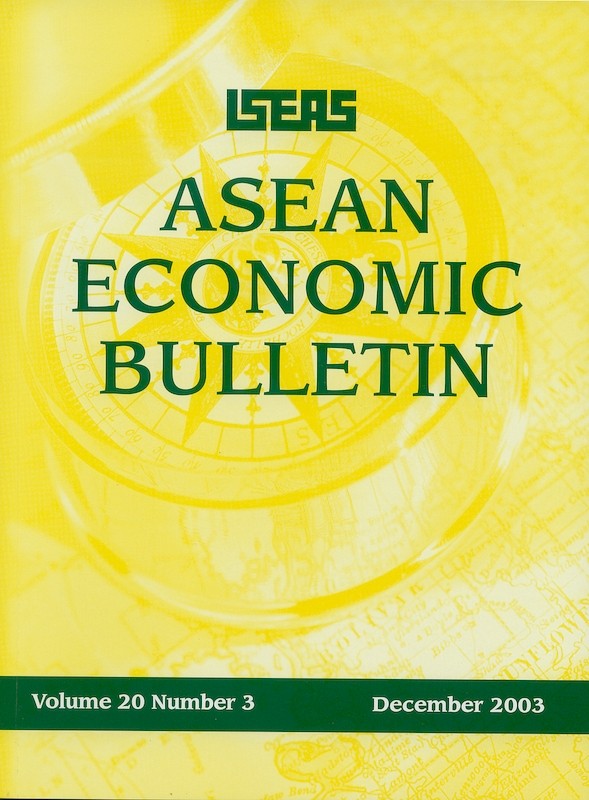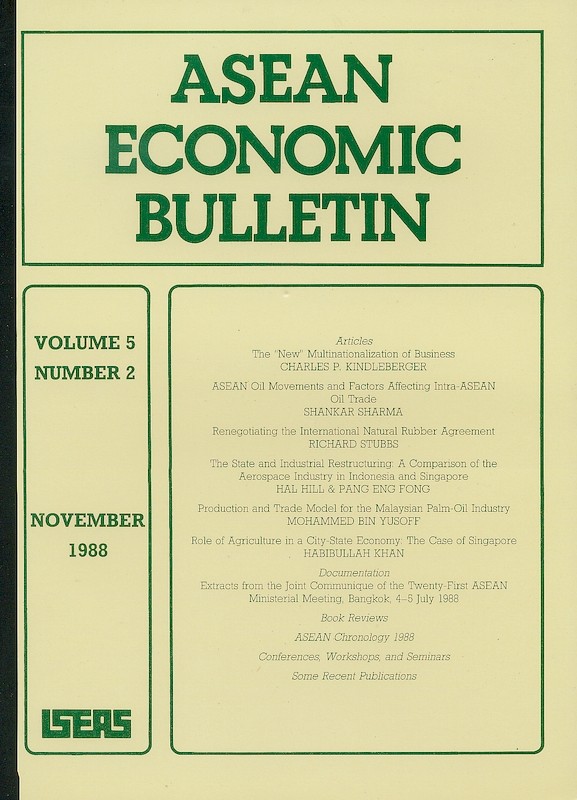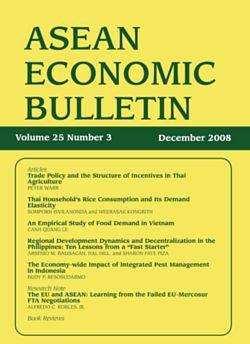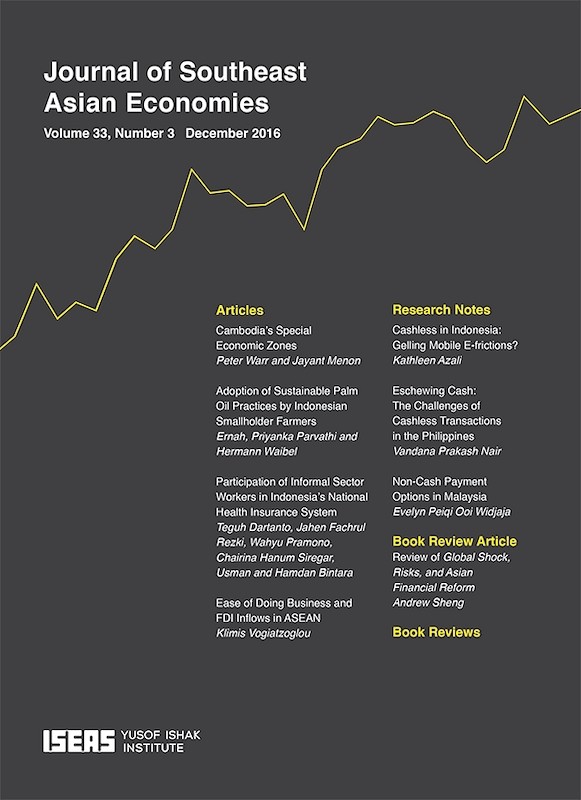ASEAN Economic Bulletin Vol. 20/3 (Dec 2003)

Date of publication:
January 2004
Number of pages:
116
Code:
AE20/3
Contents
-
ASEAN Economic Bulletin Vol. 20/3 (Dec 2003)
-
Preliminary pages
- ARTICLES
-
Measuring the Technical Efficiency of Banks in Singapore for the Period 199399: An Application and Extension of the Bauer et al. (1997) Technique, by Wai Ho Leong, Brian Dollery, Tim Coelli, authors see abstractAlthough considerable effort has been invested in the measurement of financial institution efficiency, hardly any empirical research has focused on the properties and consistency of efficiency rankings derived from the data envelopment analysis (DEA) methodology. Following the seminal work of Bauer, Berger, Ferrier, and Humphrey (1997), this paper employs data on Singaporean banking for the period 1993 to 1999 to develop efficiency scores and rankings for Singapore banks. It then invokes the five consistency conditions developed by Bauer et al. (1997) to examine these scores and rankings. Our approach allows researchers to experiment with different models and select the most appropriate model for policy purposes.
-
Exports and Long-run Growth in Vietnam, 1975-2001, by Phan Minh Ngoc, Nguyen Thi Minh Phuong, Phan Thuy Nga, authors see abstractEmploying different representative approaches and modern time series methods, this study attempts to examine the prospective long-term relationship between exports and growth in Vietnam during 1975-2001. The general conclusion of the study is that, despite the fact that the export sector has been very robust in the last decade or so, as represented by the large and increasing export share in the Vietnamese economy, there is no firm econometric evidence to suggest that the export sector has imparted a dynamic contribution to other sectors of the economy. The study also offers a number of explanations and discusses briefly some policy implications with respect to the role of exports in economic development in Vietnam.
-
ASEAN Rice Sector in the WTO: Analysis of Demand and Supply in a Liberalized Trade Environment, by Lilibeth A. Acosta, Masaru Kagatsume, authors see abstractThe ASEAN countries committed rice in regional and global trade agreements, but they remain guarded on possible unfavourable effects of trade liberalization on the rice sector. This paper aims to analyse the impact of opening the ASEAN rice sector to a globally liberalized trade environment, i.e. consistent with the WTO agreements. A Spatial Price Equilibrium model was applied in the trade analysis, whose attributes are partial equilibrium and comparative-static. The model included the five major agricultural countries in the ASEAN region (Indonesia, Malaysia, the Philippines, Thailand, and Vietnam) and the rest of the world (ROW). The results of the model indicate that the liberalization of rice trade in accordance with the WTO agreements will result in increased demand in the ASEAN region. This will be brought about by the fall in prices in the ASEAN countries. Committing to reduce the soaring level of tariffs is expected to bring about a more positive effect on Indonesian rice sector, but this favourable outcome would not be realized if WTO agreements co-exist with the implementation of the ASEAN Free Trade Area (AFTA). Finally, the WTO trade liberalization process in the time of the implementation of AFTA will effect trade diversions in the ASEAN rice sector.
-
Linking Agricultural Trade, Land Demand, and Environmental Externalities: Case of Oil Palm in Southeast Asia, by Jamal Othman, author see abstractReduction of support measures affecting soybean oil in the major soybean-producing countries, as a consequence of WTO rules, coupled with rising demand for palm oil in non-traditional palm oil-importing countries may lead to pronounced increases in agricultural land demand for oil palm expansion in Malaysia and Indonesia - two main palm oil-producing and exporting countries. However, it is expected that the effects on agricultural land demand and consequently impact upon the environment will depend much on existing governance affecting environmental and forestry management in the two countries. Given the relatively more prevalent policy and institutional failures in Indonesia, it is anticipated that deforestation consequences and open burnings in the country will be stronger, inevitably giving rise to recurring haze externalities in the region. This study employed single and multi-country output supply exogenous policy models with explicit factor markets to examine agricultural land demand-trade linkages in the world vegetable oil markets. Shifts in export demand for palm oil and reductions of support measures affecting soybean production were simulated and effects on land use in Malaysia and Indonesia were observed under varying assumptions of environmental and forestry policy regimes in the two countries. Inferences on environmental effects are also provided.
-
Capital Account and Foreign Direct Investment in the Late Nineties: What Effect on Trade?, by Joshua J. Lewer, Neil Terry, authors see abstractThe purpose of this paper is to empirically test the relationship between capital account policies and international trade in the late 1990s. A gravitational-based system is developed to identify and estimate this association for seventy-four countries and a subset of ASEAN counties. Using non-linear panel and cross-section techniques, a strong positive association is found, with foreign direct investment policies accounting for a significant portion of the total effect. The ASEAN sub-sample is found to be relatively more responsive to changes in capital account policies than the rest of the world, confirming the importance of financial liberalization in developing regions. However, this policy-trade association diminishes after the 1997-98 global contagion period for both ASEAN and world samples.
-
RESEARCH NOTE: Myanmar's Banking Crisis, by Sean Turnell, author see abstractIn early 2003 Myanmar experienced a severe banking crisis. Triggered by a collapse amongst a cohort of informal finance companies, the resultant panic quickly sparked a crisis of confidence in the country's nascent private banking sector. Prompt and credible liquidity support to the banks could have limited the damage, but Myanmar's monetary authorities proved unequal to the task. This paper examines the course taken by Myanmar's latest financial crisis, presents a critique of the policy responses to it and concludes with some thoughts on how the damage it wrought on the real economy could have been avoided.
-
RESEARCH NOTE: Framework Agreement on Comprehensive Economic Co-operation between India and ASEAN: First Step Towards Economic Integration, by Seema Gaur, author
-
RESEARCH NOTE: Realizing the ASEAN Economic Community by 2020: ISEAS and ASEAN-ISIS Approaches, by Denis Hew Wei-Yen, Hadi Soesastro, authors
-
BOOK REVIEW: Financial Liberalization and the Economic Crisis in Asia, edited by Chung H. Lee, by Sakulrat Montreevat, author
-
BOOK REVIEW: Asian States, Asian Bankers: Central Banking in Southeast Asia, by Natasha Hamilton-Hart, by Helen E S Nesadurai, author
-
BOOK REVIEW: Finance for Growth: Policy Choices in a Volatile World, A World Bank Policy Research Report., by Denis Hew Wei-Yen, author
-
BOOK REVIEW: The Emergence of a National Economy: An Economic History of Indonesia, 1800-2000, by Howard Dick, Vincent J. H. Houben, J. Thomas Lindblad, and Thee Kian Wie., by Nizam A Yunus, author
-
BOOK REVIEW: Extremes in the Archipelago: Trade and Economic Development in the Outer Islands of Indonesia, 19001942, by Jeroen Touwen., by Anthony L Smith, author
-
BOOK REVIEW: Timber Booms and Institutional Breakdown in Southeast Asia, by Michael L. Ross., by Lee Poh Onn, author

![Journal of Southeast Asian Economies Vol. 30/1 (Apr 2013) [formerly ASEAN Economic Bulletin]](/cover/AE30-1.jpg)




